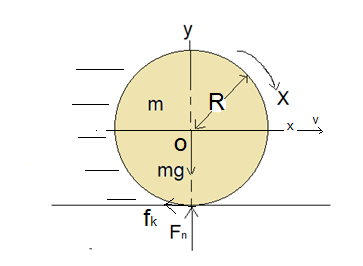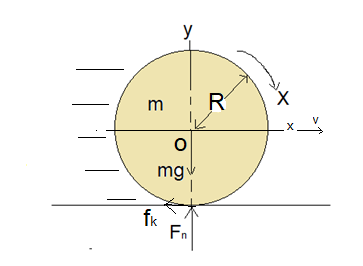
Concept explainers
(a)
The speed of the ball as it begins rolling without slipping.
(a)
Answer to Problem 107P
Explanation of Solution
Given:
Radius of the ball is
Initial speed of the ball is
The coefficient of kinetic friction between the ball and billiard table is
Forward spin of the ball just after its release is
Formula Used:

FIGURE: 1
Constant acceleration equation that relates the speed of the ball to the acceleration and time,
Where,
Referring to the force diagram shown in figure 1, applying Newton’s second law to the ball when it is rolling without slipping,
And
Where,
Calculation:
Where,
From equation
Substituting this in equation
Now,substituting the expression for
Substituting for
From equation
Moment of inertia with respect to an axis through the center of the ball is
Substituting for
Now let us write constant-acceleration equation that connects angular speed of the ball to the angular acceleration and time,
Imposing the condition for rolling the ball without slipping,
Substituting for
Now equate the equations
Substituting this
Conclusion:
The speed of the ball as it begins rolling without slipping is
(b)
The time the ball moves before it begins to rolling without slipping .
(b)
Answer to Problem 107P
Explanation of Solution
Given:
Radius of the ball is
Initial speed of the ball is
The coefficient of kinetic friction between the ball and billiard table is
Forward spin of the ball just after its release is
Formula Used:

FIGURE: 2
Constant acceleration equation that relates the speed of the ball to the acceleration and time,
Where,
Referring to the force diagram shown in figure 2, applying Newton’s second law to the ball when it is rolling without slipping,
And
Where,
Calculation:
Where,
From equation
Substituting this in equation
Now,substituting the expression for
Substituting for
From equation
Moment of inertia with respect to an axis through the center of the ball is
Substituting for
Now let us write constant-acceleration equation that connects angular speed of the ball to the angular acceleration and time,
Imposing the condition for rolling the ball without slipping,
Substituting for
Now equate the equations
Conclusion:
The time the ball moves before it begins to rolling without slipping
(c)
The distance slide down the lane by the ball before it begins rolling without slipping.
(c)
Answer to Problem 107P
Explanation of Solution
Given:
Radius of the ball is
Initial speed of the ball is
The coefficient of kinetic friction between the ball and billiard table is
Forward spin of the ball just after its release is
Calculation:
Let
Now let us write expression that relates
Average speed of the ball is,
Substituting this average speed in equation
Substituting for
Conclusion:
The distance slide down the lane by the ball before it begins rolling without slipping is
Want to see more full solutions like this?
Chapter 9 Solutions
Physics for Scientists and Engineers
- What All equations of Ountum physics?arrow_forwardPlease rewrite the rules of Quantum mechanics?arrow_forwardSuppose there are two transformers between your house and the high-voltage transmission line that distributes the power. In addition, assume your house is the only one using electric power. At a substation the primary of a step-down transformer (turns ratio = 1:23) receives the voltage from the high-voltage transmission line. Because of your usage, a current of 51.1 mA exists in the primary of the transformer. The secondary is connected to the primary of another step-down transformer (turns ratio = 1:36) somewhere near your house, perhaps up on a telephone pole. The secondary of this transformer delivers a 240-V emf to your house. How much power is your house using? Remember that the current and voltage given in this problem are rms values.arrow_forward
- The human eye is most sensitive to light having a frequency of about 5.5 × 1014 Hz, which is in the yellow-green region of the electromagnetic spectrum. How many wavelengths of this light can fit across a distance of 2.2 cm?arrow_forwardA one-dimensional harmonic oscillator of mass m and angular frequency w is in a heat bath of temperature T. What is the root mean square of the displacement of the oscillator? (In the expressions below k is the Boltzmann constant.) Select one: ○ (KT/mw²)1/2 ○ (KT/mw²)-1/2 ○ kT/w O (KT/mw²) 1/2In(2)arrow_forwardTwo polarizers are placed on top of each other so that their transmission axes coincide. If unpolarized light falls on the system, the transmitted intensity is lo. What is the transmitted intensity if one of the polarizers is rotated by 30 degrees? Select one: ○ 10/4 ○ 0.866 lo ○ 310/4 01/2 10/2arrow_forward
- Before attempting this problem, review Conceptual Example 7. The intensity of the light that reaches the photocell in the drawing is 160 W/m², when 0 = 18°. What would be the intensity reaching the photocell if the analyzer were removed from the setup, everything else remaining the same? Light Photocell Polarizer Insert Analyzerarrow_forwardThe lifetime of a muon in its rest frame is 2.2 microseconds. What is the lifetime of the muon measured in the laboratory frame, where the muon's kinetic energy is 53 MeV? It is known that the rest energy of the muon is 106 MeV. Select one: O 4.4 microseconds O 6.6 microseconds O 3.3 microseconds O 1.1 microsecondsarrow_forwardThe Lagrangian of a particle performing harmonic oscil- lations is written in the form L = ax² - Bx² - yx, where a, and are constants. What is the angular frequency of oscillations? A) √2/a B) √(+2a)/B C) √√Ba D) B/αarrow_forward
- The mean temperature of the Earth is T=287 K. What would the new mean temperature T' be if the mean distance between the Earth and the Sun was increased by 2%? Select one: ○ 293 K O 281 K ○ 273 K 284 Karrow_forwardTwo concentric current-carrying wire loops of radius 3 cm and 9 cm lie in the same plane. The currents in the loops flow in the same direction and are equal in magnitude. The magnetic field at the common center of the loops is 50 mT. What would be the value of magnetic field at the center if the direction of the two currents was opposite to each other (but their value is kept constant)? Select one: ○ 20 mT ○ 10 mT O 15 mT ○ 25 mTarrow_forwardAn ideal coil of inductivity 50 mH is connected in series with a resistor of 50 ohm. This system is connected to a 4.5 V battery for a long time. What is the current in the circuit? Select one: O 45 mA ○ 90 mA 00 mA O 150 mAarrow_forward
 Principles of Physics: A Calculus-Based TextPhysicsISBN:9781133104261Author:Raymond A. Serway, John W. JewettPublisher:Cengage Learning
Principles of Physics: A Calculus-Based TextPhysicsISBN:9781133104261Author:Raymond A. Serway, John W. JewettPublisher:Cengage Learning Physics for Scientists and Engineers: Foundations...PhysicsISBN:9781133939146Author:Katz, Debora M.Publisher:Cengage Learning
Physics for Scientists and Engineers: Foundations...PhysicsISBN:9781133939146Author:Katz, Debora M.Publisher:Cengage Learning University Physics Volume 1PhysicsISBN:9781938168277Author:William Moebs, Samuel J. Ling, Jeff SannyPublisher:OpenStax - Rice University
University Physics Volume 1PhysicsISBN:9781938168277Author:William Moebs, Samuel J. Ling, Jeff SannyPublisher:OpenStax - Rice University Classical Dynamics of Particles and SystemsPhysicsISBN:9780534408961Author:Stephen T. Thornton, Jerry B. MarionPublisher:Cengage Learning
Classical Dynamics of Particles and SystemsPhysicsISBN:9780534408961Author:Stephen T. Thornton, Jerry B. MarionPublisher:Cengage Learning Glencoe Physics: Principles and Problems, Student...PhysicsISBN:9780078807213Author:Paul W. ZitzewitzPublisher:Glencoe/McGraw-Hill
Glencoe Physics: Principles and Problems, Student...PhysicsISBN:9780078807213Author:Paul W. ZitzewitzPublisher:Glencoe/McGraw-Hill College PhysicsPhysicsISBN:9781305952300Author:Raymond A. Serway, Chris VuillePublisher:Cengage Learning
College PhysicsPhysicsISBN:9781305952300Author:Raymond A. Serway, Chris VuillePublisher:Cengage Learning





